“There are only two kinds of people who are really fascinating — people who know absolutely everything, and people who know absolutely nothing.” (Oscar Wilde, from The Picture of Dorian Gray)
COMICS
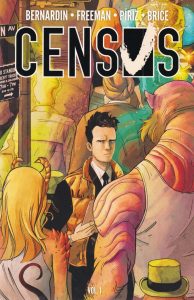 Census volume 1 by Marc Bernardin (writer), Adam Freeman (writer), Sebastián Píriz (artist/colorist), Bernardo Brice (letterer), and Sarah Litt (editor). $22.99, 99 pgs, Dark Horse/ComiXology.
Census volume 1 by Marc Bernardin (writer), Adam Freeman (writer), Sebastián Píriz (artist/colorist), Bernardo Brice (letterer), and Sarah Litt (editor). $22.99, 99 pgs, Dark Horse/ComiXology.
Census feels a bit rushed at the end, which is weird because it definitely ends with a promise of a second volume, so why Bernardin and Freeman felt they had to wrap things up when they don’t actually wrap things up is odd. Up until then, this is a fun, nifty comic (and the rushing doesn’t ruin it, it’s just annoying) – a slacker gets a job as a census taker, but it turns out it’s a census of New York’s supernatural beings, and he can’t quit because he kind-of sort-of made a deal with the devil to work on the job. Out hero, Liam, is a decent enough character – he just wants a job, but he doesn’t want to work too hard, so census taking – especially because the wage is high – seems great, but at his first stop, he’s almost sacrificed by three succubi because he’s a virgin. One of the ladies takes pity on him and has sex with him so the sacrifice will be spoiled, and she becomes his quasi-love interest as he goes around the city. His boss tells him he just needs to count the supernatural beings, but of course, he finds that he’s growing a conscience, especially when he realizes that some of these beings are up to nefarious a-doings (not Cthulhu, though – he’s pretty chill), but his boss doesn’t want him to get involved. Naturally, he does, and that leads to the final issue, where he has to work his way back from hell and that leads to a new story arc (possibly). Bernardin and Freeman have fun with the various things involved, and the book has a lot of good humor, but they also make sure that there’s a sense of menace, too, as these beings don’t necessarily want to be tabulated. The only misstep is the parade Liam hijacks (which is the final straw for his boss), not because of the reasons he does it, but because it just seems like a bizarre and unlikely solution to what he perceives as the problem (and the fact that is doesn’t work is handled well by the writers). Overall, though, this is a cool comic. Píriz’s art is nothing spectacular, but it’s pretty solid, and he does a good job showing how mundane Liam’s work can be even though he’s dealing with weird creatures. I mean, he’s still just a bureaucrat, and Píriz does a decent job making the work look boring, so when it suddenly isn’t, it’s a good contrast. Anyway, this is a fun book. Nothing too unforgettable, but still fun.
Rating: ★ ★ ★ ★ ★ ★ ★ ☆ ☆ ☆
One totally Airwolf panel:

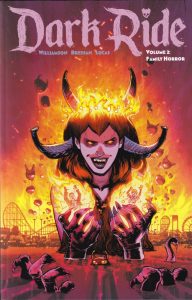
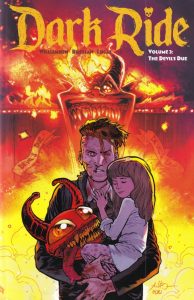 Dark Ride volumes 2-3 by Joshua Williamson (writer), Andrei Bressan (artist), Adriano Lucas (colorist), Pat Brosseau (letterer), and Amanda LaFranco (editor). $14.99 and $19.99 (!), 96 and 88 pgs, respectively, Image.
Dark Ride volumes 2-3 by Joshua Williamson (writer), Andrei Bressan (artist), Adriano Lucas (colorist), Pat Brosseau (letterer), and Amanda LaFranco (editor). $14.99 and $19.99 (!), 96 and 88 pgs, respectively, Image.
Yep, the third volume is shorter AND more expensive. Late-stage capitalism RULEZ!!!
For some reason, I didn’t get volume 2 when it came out, so when volume 3 showed up, I asked my retailer to get volume 2, hence the double whammy of this. This completes the series, which is only 12 issues, and I wonder if that’s why I don’t love it as much as I did Birthright, Williamson and Bressan’s previous series, which ran considerably longer. This is a perfectly good series, but it felt a bit … lighter than Birthright, as Williamson had a fairly simple “Faust” story to tell (with a few fun twists) and didn’t care too much about developing a lot of characters. He burns right through the plot, and it’s hard to care or root for any character, because the only really sympathetic character is a bit secondary, while the two main-ish characters, Samhain and Halloween (brother and sister children of the creepy founder of the devilish theme park, Arthur Dante), are kind of jerks, and even as Samhain becomes more and more keen on stopping whatever his father is doing and rescuing his wife and kid, he really doesn’t become that compelling a character. I mean, he’s fine, but his plight doesn’t feel as real as it could be, and the story feels a bit lessened because of it. Williamson has fun with the horror tropes he plays with – setting this story in an amusement park is clever, as it allows the characters to comment on some of the absurdity even as there is very bad stuff going on, and the final Big Confrontation is played as metatextually as possible (and it’s fairly fun because of it, despite the direness of the situation), but the book still lacks a bit of humanism that would make the problems of Samhain and Summer (the sympathetic character) more interesting. Bressan and Lucas, naturally, make the book look superb, from Samhain’s fight with an animated demon to the Big Confrontation at the end, which is spectacular, and the book is certainly enjoyable, but it just lacks a bit of what made Birthright so interesting. I don’t know if this creative team has something else lined up, but I will definitely read it, because they know what they’re doing. If you enjoy horror, this is a pretty cool book. I just wish it had been a bit … more.
Rating: ★ ★ ★ ★ ★ ★ ★ ☆ ☆ ☆
One totally Airwolf panel:
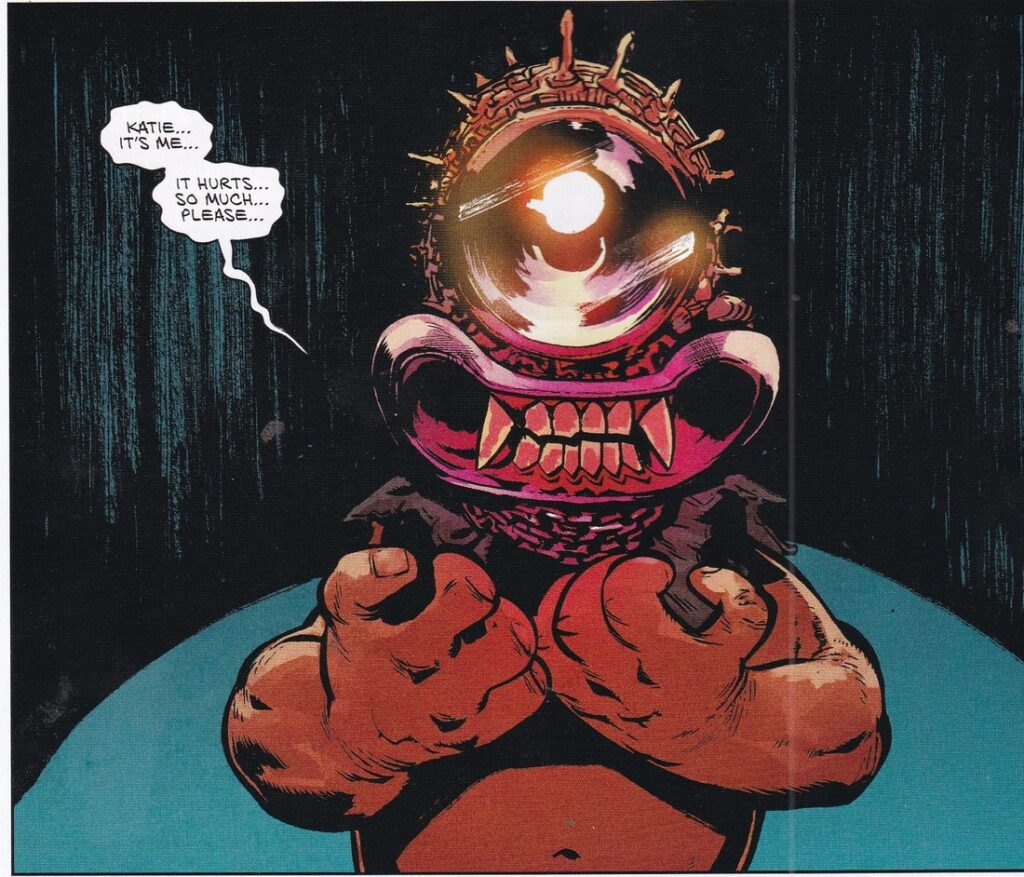
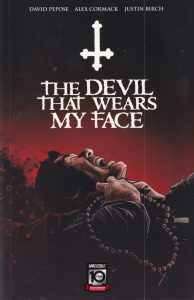 The Devil That Wears My Face by David Pepose (writer), Alex Cormack (artist/colorist), Justin Birch (letterer), Christina Harrington (editor), and Mike Marts (editor). $17.99, 132 pgs, Mad Cave Studios.
The Devil That Wears My Face by David Pepose (writer), Alex Cormack (artist/colorist), Justin Birch (letterer), Christina Harrington (editor), and Mike Marts (editor). $17.99, 132 pgs, Mad Cave Studios.
Cormack is apparently the artist you go to these days if you want good, bloody horror, and he delivers quite well in this blood-soaked tale, which has an intriguing premise: it’s 1740, and a priest is sent to a Spanish castle to exorcise the son of a nobleman, but the demon inside the son manages to switch souls with the priest, so the demon now inhabits the priest’s body while the priest is sharing the body of the son. Of course, the demon can now get into all kinds of mischief in Rome, while in Spain, the priest manages to free himself, convince the comely lass who’s a childhood friend of the family that he’s actually the priest, and they head to Rome to exocize the demon once and for all and repair the damage he’s wreaking, because he’s wreaking a lot of it. Cormack has a good, strong, angular line, so his character always look like stone that’s been chipped away at by life, which fits well with the hard situations they always find themselves in when he’s drawing a comic, and he’s so precise with his lines that when our priest, Franco Vieri, battles for his soul and the soul of the son in what appears to be hell, Cormack can use a blurring effect (which seems to come about simply through his line work and some good gouache effects, and not through digital manipulation of the image) and it’s still clear what he’s drawing. He really packs the page at times, as Vieri is chased through the streets of Rome by possessed Swiss guardsmen in a frenzy of action, and later, Vieri comes up with a novel solution to his demon problem that requires Cormack to do some extremely detailed work, but he pulls it off. A lot of Cormack’s comics have taken place at night or in dark places, so it’s not always clear to see his work, and while a lot of this is dark, too, at a lot of points he gets to color the book a bit more brightly, and it’s really cool to see. He also uses painted effects to imply the supernatural presence of the demon, which works quite well. Cormack has done a lot of good work in comics, and it would be nice if he got some higher-profile work.
Pepose’s story, meanwhile, is a pretty good twist on a standard demon possession yarn. The change might not be unique, but it feels fresh, and that’s always nice (I’m not up on my “demon possession fiction” as much as some, so I don’t know if it’s been done before). “Vieri” goes to Rome and wreaks havoc, but Pepose does a nice job showing how easily he can do it simply by playing on the Church’s paranoia about heretics and free-thinkers, which leads him to the papacy after he kills the old pope (I don’t know how much research Pepose did about the dates, but Clement XII did die in 1740, he was pretty danged old, and he was often in bed, which is how Pepose depicts his pope, but needless to say, he was not butchered – he died of gout). Of course, He! Must! Be! Stopped! and all that, but Pepose does it in an interesting and not always expected way, so that’s keen. In a lot of ways, it’s a fairly standard horror story, but Pepose does enough with some of the ancillary details that it becomes a bit more clever and fun to read.
This is a cool book. Give it a look!
Rating: ★ ★ ★ ★ ★ ★ ★ ½ ☆ ☆
One totally Airwolf panel:

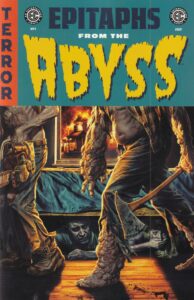
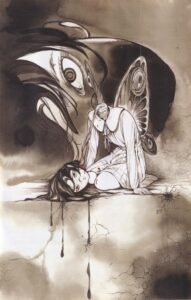 Epitaphs from the Abyss #1 and Hello Darkness #1 by lots of people. $4.99 and $5.99, 33 pgs and 40 pgs, Oni and Boom! (respectively).
Epitaphs from the Abyss #1 and Hello Darkness #1 by lots of people. $4.99 and $5.99, 33 pgs and 40 pgs, Oni and Boom! (respectively).
Interestingly enough, both new horror anthologies came out on the same day (the 24th of July), despite the editorial in the back of the Boom! one about how anthologies don’t sell (the editorial writer, Bryce Carlson, who edits Hello Darkness, also seems to take a shot at Epitaphs, but I suppose he could claim he wasn’t, really), so we’ll see how they do. I go back and forth on buying anthologies and waiting for the trade (Creepshow, for instance, I got in trade), but I figured I’d at least check these out, just for fun. Oni is claiming they’re reviving the EC brand, which they are, but why? It’s unclear, and Epitaphs is just … well, it’s a horror anthology. I mean, good for them and all, but unless you’re digging up Wallace Wood and Johnny Craig and Al Feldstein, branding it “EC” seems superfluous. I guess if it helps sell the book, more power to them.
Anyway, Hello Darkness is just slightly better than Epitaphs, but they’re both solid horror anthologies. Epitaphs gives us four stories – 8, 10, 8, and 6 pages long – while Darkness has six stories – 8, 6, 5, 3, 6, and 11 pages long, plus a gag page by Robert Hack. Darkness has two continuing stories – Tynion and Dell’Edera do a Something Is Killing the Children intro, while Garth Ennis and Becky Cloonan (the book’s main draw) have the long chapter at the end, as a group of friends in New York have to deal with a nuclear war (the story is a lot of talking about Russia and Ukraine, and it ends with the war beginning). I don’t know if Ennis is trying to make the characters the tiniest bit obnoxious, as they’re a bunch of hipsters (there’s a man bun!) talking about things they have no experience with but suddenly, it appears they’re going to have plenty of experience, but it’s not a bad opening, and Cloonan’s art is terrific, of course. The other stories in Darkness are decent – a bunch of kids start murdering their parents, and I guess we’re supposed to understand why by the end, but I didn’t, exactly; an old bowler gets grumpy that a young punk gets a chance to bowl in the “big leagues,” so he goes nuts – this story is very, very darkly humorous, as a lot of good horror is; a guy in a lighthouse hears a siren, but resists her … a bit; a narcissistic dude gets a “foster” hand (it makes sense if you don’t worry about it!) so he can be seen as a hero, and that doesn’t go as he planned (this story is drawn by A.L. Kaplan, who’s a really good artist who doesn’t get nearly enough work). In Epitaphs, the stories are a bit more … EC-like, maybe? All are self-contained, and they all have nasty twists in them that make them more in the 1950s EC vein. In one, a writer who thinks he’s a genius reads his roommate’s screenplay, which is truly a work of genius, and that doesn’t go over well; a reporter wonders why a conservative, pro-choice senator changed her tune and finds out something nasty about politics; a man is forced to either kill himself or one member of his family or a bunch of armed thugs will kill all of them, and of course there’s a fun twist at the end (Phil Hester draws this, and it’s the best looking and best designed art in the book); and two people are hiding out from a group of deformed humans with a sinister (and, of course, twistedly humorous, because EC) agenda.
Are any of these stories going to change your life? Of course not! However, they’re still fun to read, even if some (the kids killing their parents) are a bit too vague or others (the reporter tracking the senator) are a bit too goofy. There’s some good talent on the stories (Jorge Fornés, Peter Krause, Brian Azzarello, Steve Orlando), and even the lesser-known creators do good work. I’m not sure how long Ennis’s serial is running, but a slightly restrained Ennis is the best Ennis, and this chapter, at least, is fairly restrained. I’ll have to think about getting these in single issue format going forward, but they’re both off to solid starts.
Rating: ★ ★ ★ ★ ★ ★ ★ ★ ☆ ☆ ☆ (maybe 7¼ for Hello Darkness?)
One (from each) totally Airwolf panel:


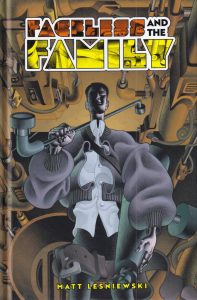 Faceless and the Family by Matt Lesniewski (writer/artist), Zack Soto (editor), and Karl Bollers (editor). $29.99, 120 pgs, Oni Press.
Faceless and the Family by Matt Lesniewski (writer/artist), Zack Soto (editor), and Karl Bollers (editor). $29.99, 120 pgs, Oni Press.
Lesniewski is a good artist, and he gives us one of the most inventive and fascinating visual stories since Seth Fisher was alive, as he creates a weird, hand-shaped world where the rich live on the fingers and the poor live on the palm, then populates it with oddball characters and turns them loose. He doesn’t give us the greatest story – a man who wears a stovepipe on his head wants to get facial surgery even though, as many people tell him, he’s an attractive dude (we never see his full face), but he has his reasons! He meets up with a bunch of outcasts and, naturally, they bond over the fact that they’re outcasts and grow to love each other, and our hero, Faceless, realizes he has people to have his back, because he definitely needs people having his back. It’s a simple story and doesn’t take any sharp turns we don’t expect, but it also doesn’t matter too, too much, because the joy in this book is looking at Lesniewski’s art, which is staggering. He does wonderful things with the characters, from Faceless’s ridiculous helmet to Carp’s astonishing ponytail, which trails from her like a living comet’s tail, and his world his full of wild and wacky details that make it look fully lived in. His characters are fluid and funky, moving across this bizarre world with different, unique gaits, and each character is designed in a specific way, so that we get an interesting spectrum of body types and faces. His precise line work makes the details of this world wonderful, and when Faceless and his group get to the city, Lesniewski does a superb job contrasting it with the wasteland from which they come – it’s supposed to be where the upper classes live, and it certainly has more “civilization,” but it’s also crowded and unpleasant, and Lesniewski shows us all this without taking any panel off. His fight scenes are full of bendy and twisty figures, and, in a very Fisher-esque move, his sound effects are often three-dimensional and appear to be objects in the scene, not just sounds being made. Lesniewski’s amazing hatching adds texture to the figures and shading to the landscape, and he does a marvelous job varying line weights to add heft to certain things while keeping other things a bit in the background. This really is a beautiful book – every panel gives you something to linger over, and it’s just fun to look at all the little things in each one. While the story is nothing to write home about, this is a pretty cool comic to check out.
Rating: ★ ★ ★ ★ ★ ★ ★ ½ ☆ ☆
One totally Airwolf panel:

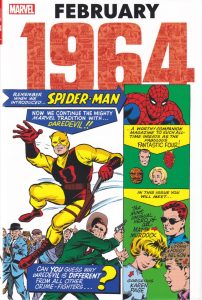 Marvel: February 1964 Omnibus by Shameless Self-Promoter Stan Lee (“writer”), Seriously Underappreciated Artists Jack Kirby, Steve Ditko, and (probably) Bill Everett (artists and probably a good amount of writing, too), and a crap-ton of others. $100.00, 480 pgs, Marvel.
Marvel: February 1964 Omnibus by Shameless Self-Promoter Stan Lee (“writer”), Seriously Underappreciated Artists Jack Kirby, Steve Ditko, and (probably) Bill Everett (artists and probably a good amount of writing, too), and a crap-ton of others. $100.00, 480 pgs, Marvel.
This is the first one of these omnibuses I’ve managed to finish (there have been three others), and it’s pretty fun – more superhero stuff than the first one, obviously (which gathered all the comics Marvel put out in the month Fantastic Four #1 came out), including Daredevil #1, which is the reason this one exists – but still plenty of romance/model comics and Westerns. Everett does gorgeous work on DD #1, although, as usual, so many comics from this time period would have been better off uncolored – in the back, we get a few pages of Everett’s original pages, and the inks are just amazing, and while the coloring doesn’t completely obscure it, it still tempers it far too much (this is true of the other uncolored examples in the back of the book – some Larry Lieber, Don Heck, Ditko, and Dick Ayers pages, although none of those are as gorgeous uncolored as Everett’s are) – and we also get a bunch of Kirby, as he draws the lead story in Journey Into Mystery #103 (13 pages), the “Tales of Asgard” story in JIM #103 (5 pages), the lead story in Strange Tales #120 (14 pages), Fantastic Four #26 (23 pages), The Avengers #5 (23 pages), Sgt. Fury and His Howling Commandos #7 (22 pages), and X-Men #5 (24 pages) – 113 pages in a month, because the King cares not for modern-day wussie artists who can’t even finish one book a month! Stan Goldberg was cranking them out, too, as he draws most of the “Millie the Model” universe, but his art doesn’t seem like it would take as long, as it’s a bit more simplistic than Kirby’s. Anyway, this is a fun book. Millie is always awesome, Patsy and Hedy get up to their usual shenanigans, the Two-Gun Kid, Kid Colt, and the Rawhide Kid (teaming up with the Two-Gun Kid in a weird crossover, as Marvel implies that the Two-Gun Kid is published by a different company) dole out justice, Fury gets court-martialed (but it all works out in the end), and the superheroes do superhero stuff. Hank Pym and Janet van Dyne (written as sexist-ly as possible, because the Sixties) fight the Human Top; Odin tries to break up Thor and Jane Foster by getting Loki to send the Enchantress to tempt him (it doesn’t work, natch); the Black Widow, still on the side of the filthy Commies and still wearing evening wear instead of a much less sexist latex catsuit, fights Iron Man; we get the Watcher’s origin (hey, that’s handy); Doctor Octopus unmasks Spider-Man in front of Betty Brant and J. Jonah Jameson, but nobody (including Doc Ock) believes Puny Parker™ is actually Spider-Man, choosing instead to believe he just dressed up as Spidey to try to get a scoop (so why didn’t the “real” Spider-Man show up, asks no one); the Torch and Iceman team up to stop pirates on a boat going around Manhattan; Doctor Strange visits a haunted house; the Thing fights the Hulk and the Avengers get in the way; the Lava Men attempt to destroy the “surface dwellers” and the Avengers need to stop them; and the X-Men fight Magneto without Xavier’s help and manage to hold their own (and boy howdy, is Xavier a dick in this issue – his dickishness is baked into the foundation of the X-Men, it seems!). It’s all very fun and goofy, with some very weird things butting up against Marvel’s attempts at “realism.” I don’t know where else Marvel can go with this – all the big guns have been introduced, so they can’t do a “first Thor” Omnibus or anything like that. I would love to see them jump ahead and do a “first Ghost Rider” Omnibus or something from the 1970s, even if by then, it’s all superheroes. We shall see. I know this is a chunk of money and a lot of these things have been reprinted elsewhere, but these “what we were publishing in that month” omnibuses are pretty keen.
Rating: ★ ★ ★ ★ ★ ★ ★ ★ ☆ ☆
One totally Airwolf panel:
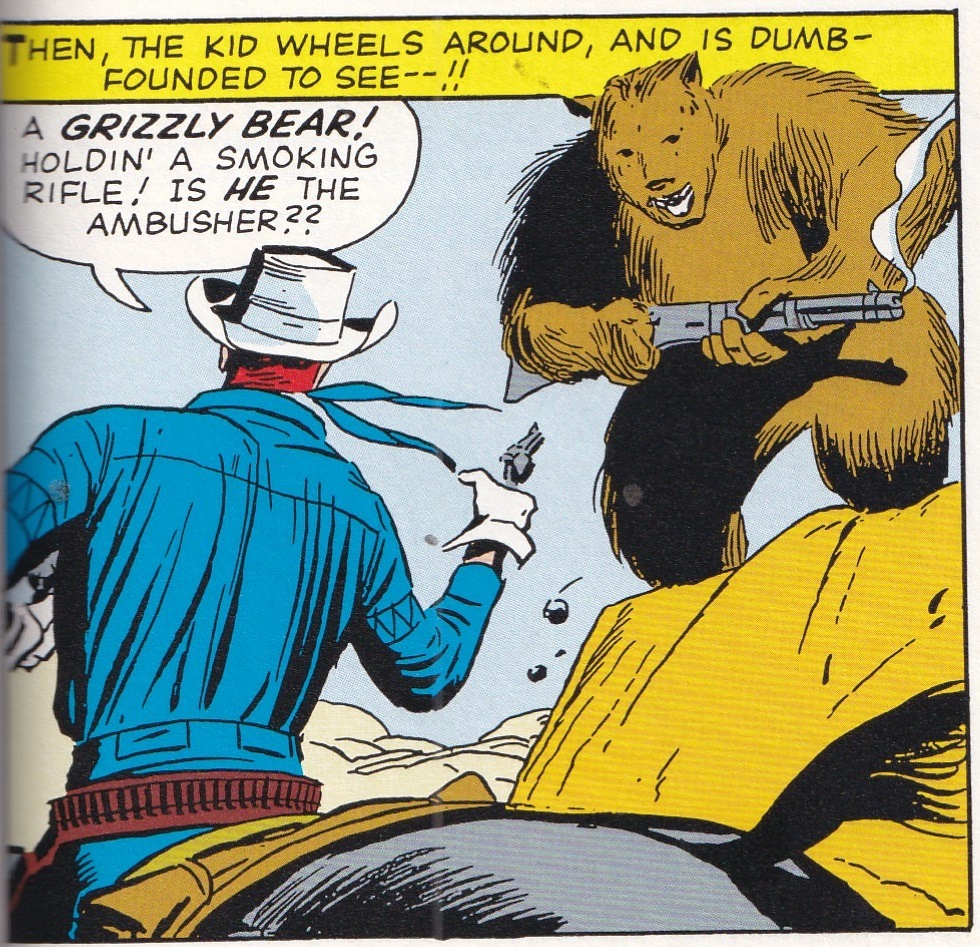
 Rock Candy Mountain: The Collected Edition by Kyle Starks (writer/artist), Chris Schweizer (colorist), and Dylan Todd (letterer). $19.99, 196 pgs, Image.
Rock Candy Mountain: The Collected Edition by Kyle Starks (writer/artist), Chris Schweizer (colorist), and Dylan Todd (letterer). $19.99, 196 pgs, Image.
I’ve liked Starks’s comics in the past, so when we got a new edition of one of his early ones (it’s from the late teens!), I figured I’d check it out – you can’t beat the price for that much content! It’s a fun comic with plenty of heartfelt emotion, so it’s enjoyable to read. Starks doesn’t break too much new ground, storytelling-wise, but what the heck, right? We get hobos in a post-Second World War ‘Murica just trying to make their way, and Jackson, our hero, is just trying … well, I don’t want to give away what he’s trying to do, but he’s bummed because his wife and daughter are dead, and he’s on a quest, and those two things are linked and let’s just leave it at that. He picks up a dude, Slim, who’s trying to get back to Kentucky from Hollywood and who considers himself the unluckiest person in the world, and those two form a nice friendship, although it’s rocky for a while because Jackson keeps getting them both into very real danger and doesn’t seem to care (there’s a reason for it, but I won’t tell). Meanwhile, the Devil is after Jackson (you know, like he does), as is the FBI, and while we find out why the Devil is after him, it remains unclear why the Feds want him (there’s a reason, but it’s not a very good one). Oh, and a whole bunch of hobos don’t like Jackson because he insulted their leader. So, what we have is Jackson on a quest, a lot of people trying to stop and/or kill him, and Slim along for the ride. Starks rarely lets up with the relentless pace, which is fine because it’s an adventure, and he manages to work in some good emotional moments, too (again, not groundbreaking ones, but nice ones). This is, for all of Starks’s cartoonish art style, a fairly violent book (even when the Devil isn’t around wrecking shit), and there’s a lot of tension in the fights, because Starks lets us know early on that some of the participants are really, really tough, so they won’t go down easy! All in all, it’s an engaging adventure, and it’s nice that it’s out in a complete collection, which also includes some nice essays in the back about hobos and … other things, but I don’t want to spoil it because it will spoil part of the plot! Just pick it up and get to reading!
Rating: ★ ★ ★ ★ ★ ★ ★ ½ ☆ ☆
One totally Airwolf panel:

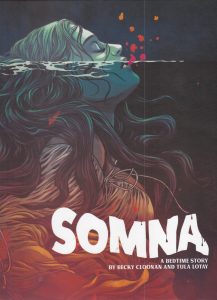 Somna by Becky Cloonan (writer/artist), Tula Lotay (writer/artist/colorist), Lee Loughridge (colorist), Dee Cunniffe (colorist), Lucas Gattoni (letterer), and Will Dennis (editor). $30.00, 149 pgs, Dstlry.
Somna by Becky Cloonan (writer/artist), Tula Lotay (writer/artist/colorist), Lee Loughridge (colorist), Dee Cunniffe (colorist), Lucas Gattoni (letterer), and Will Dennis (editor). $30.00, 149 pgs, Dstlry.
Friends, I am not someone who is going to blow smoke up your ass or anywhere near your body. I certainly like dissecting comics, perhaps too much according to some of you, and I like trying to break down themes and metaphors and whatnot in fiction, especially comics. I like using high-falutin’ words when it suits me, because high-falutin’ words are fun. But I will also tell it like it is, because occasionally, comics need to be punctured a bit because they get too full of themselves. On the back of this very nice hardcover (seriously – I do hope Dstlry is doing/does well, because not only is Chip Mosher a co-founder, and Chip’s a good dude, but their actual products are gorgeous), the “solicit” reads: “SOMNA’s intoxicating blend of history, eroticism, and the supernatural will transport readers to a world where passion and spirits intertwine, enrapturing your senses and leaving you craving more ..” No time for a proper ellipse in that description! If you read between the lines of this breathless synopsis, you can perhaps glean what Somna actually is: IT’S SOFTCORE PORN! I mean, listen, there’s nothing wrong with that, but come on – it’s porn. Beautifully drawn porn, to be sure, but still.
I mean, in the first few pages of the book, our heroine, Ingrid, is dreaming about a dark, mysterious, demonic man who turns her on, so she starts masturbating. Pages 1-6, everyone! Lotay draws the “supernatural” stuff, in general, while Cloonan sticks to the “real” world, but it’s clever how through the course of the book, Lotay illustrates some things we think of as the “real” world, but supernatural stuff is beginning to intrude upon it. Both women are excellent artists, but they have wildly different styles, so it’s really a beautifully realized book, because it really shifts nicely. Lotay uses thin lines, lush painted effects, and lighter brush work, and her art is always slightly ethereal, even when she’s working on books that don’t require it. Cloonan uses heavier lines and more spot blacks, and her work is much more grounded, so it’s fascinating to see how Ingrid shifts between both worlds. The mysterious “demon” is all blackness and fuzzy edges and hypnotic eyes, while Roland, Ingrid’s husband, is solid and earthbound. Late in the book, the two artists switch a little bit, so that Cloonan gets to draw a weird, unreal scene and Lotay gets to draw a few pages in a courtroom, and just by doing that, the creators are able to call into question how much of what Ingrid is experiencing is actually “real.” That’s one very good thing about the book, and it stems from the artwork.
As for the story … I mean, who cares, really? It’s porn – does the story matter all that much? Does this take place colonial North America, as is implied? Does it take place in Europe, as the names – Ingrid, Sigurd, Roland, Maja – imply? Unsurprisingly, the men in this book are sexually repressed, the women are hot ‘n’ horny, there’s an extra-marital affair, there’s murder, there are witch trials – it’s all very generic, but that’s ok! Neither Lotay nor Cloonan are terribly experienced writers, and, frankly, a lot of writers who should know better fall into generic traps all the time. At least Cloon and Lotay keep things zipping along, and Ingrid and her husband, Roland, have (it feels) a better relationship than you might expect (not a great one, because he’s too busy out hunting witches to give his wife what she really wants, which is … well, you know), and the writers don’t take any easy ways out in this story, but it’s still not that great. It moves inexorably and predictably toward its conclusion, and it’s too bad that they didn’t try to change things up too much.
But! it’s still a nifty book. The art is gorgeous, and hey, it certainly doesn’t look like porn, so you can read it on the bus while you’re going to work! Everyone wins!
Rating: ★ ★ ★ ★ ★ ★ ½ ☆ ☆ ☆
One totally Airwolf panel:

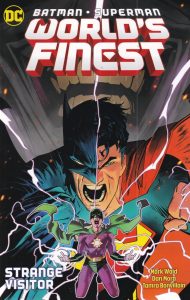 World’s Finest volume 2: Strange Visitor by Mark Waid (writer), Dan Mora (artist), Travis Moore (artist), Tamra Bonvillain (colorist), Steve Wands (letterer), Aditya Bidikar (letterer), and Paul Kaminski (collection editor). $17.99, 130 pgs, DC.
World’s Finest volume 2: Strange Visitor by Mark Waid (writer), Dan Mora (artist), Travis Moore (artist), Tamra Bonvillain (colorist), Steve Wands (letterer), Aditya Bidikar (letterer), and Paul Kaminski (collection editor). $17.99, 130 pgs, DC.
In the first volume of this series, Robin (Dick Grayson, because all DC comics exist in some amorphous non-time now, where everyone who was ever a character currently is that character) got lost in time, but nobody seemed unduly concerned. We think that’s going to be the focus of this volume, but … Waid just wanted to write a one-issue murder mystery set in 1892 for some reason? Dick hooks up with a circus to pass the time, and someone has killed some people and blamed it on the animals. Dick says he want to investigate, and while he’s doing so, Batman and Superman show up, because traveling through time in the DCU is apparently as easy as me going downstairs to make a Pop-Tart. They solve the mystery and return to the “present,” and all’s well that ends well. It’s very odd – not a bad story, but odd that it’s treated so cavalierly.
Anyway, then Waid gets to the main story, which is about a kid who gets sent to this dimension by his parents because his world is doomed. Oh dear, that sounds familiar (Waid puts a nifty twist on it, though). What’s interesting and neat about Waid is that he’s been writing comics for so long and he has an exhaustive knowledge of DC history, so he uses characters that have been around a while but might not be too popular, and he does that here. You, a smart, long-time DC reader, already know what’s going on with the kid (I mean, unless you haven’t read the book, but he’s not a new creation), but Waid also has other, odder characters make cameos in this book, and while I assume they’re all long-established, I can’t be sure Waid didn’t invent one or two of them. The main villain of the book is the Key, who I always liked, and Waid does good work with him. Oh, sure, the Joker is there, too, but his presence there is a bit dumb, unfortunately. I’ll get back to him. Anyway, the kid from another dimension has powers, but he doesn’t know how to control them, and both Superman and Batman try to help him (so do the Teen Titans, who guest star in this volume). The kid has deep psychological issues, though, and that doesn’t work too well in comics, because usually anyone with deep psychological issues becomes a supervillain (it’s not Waid’s fault – he didn’t invent the trope – but there’s not a lot he can do about it in this comic, either). So the kid seems to be sliding toward supervillainy, and Superman is kind of helpless. This is why the Joker’s presence is kind of dumb – the Key is sort of working for him, but it’s very unclear what the Joker – or the Key, for that matter – wants, so they’re just out there being evil. When the heroes manage to get to the Joker, the Kid From Another Dimension starts beating him up, almost killing him, which is Superhero 101 for “This dude has serious psychological issues” even though literally anyone in the world would want to beat the Joker to death, and if there’s anyone in the DCU who deserves it, it’s him. But our heroes can’t have that, no! and so they believe that the KFAD is too far gone for help. I won’t spoil what happens, but needless to say, he won’t be a problem for some time … but only for some time, not forever!
Mora does his usual stellar job on the art, which is unsurprising. I was struck by the Key’s appearance, because he looks like the late-’90s redesign that Grant Morrison and their artists gave him in JLA (I want to say Oscar Jimenez was the artist on the first redesign issue, but I don’t know if he did the actual redesign). The reason I like this is because he still has long, stringy hair, which was a big trend back in the 1990s, and I wonder why current artists don’t change characters’ “looks” with the times. I mean, the Key could get a haircut, couldn’t he? I guess he’s too busy expanding his mind to care about his personal appearance, but I do find it funny that some characters look very much like the time period in which they were designed and they stay that way even if the culture moves on. But that’s just me. Anyway, Mora is a good superhero artist, this is a superhero book, so the book looks very keen. You know the drill!
I’m not sure if I’m going to continue with this series. It’s fine, but it’s nothing great, and I wanted to read it because everyone was raving about it, but it’s just a well-done superhero comic. I mean, great and all, but nothing I haven’t read before. We shall see. It’s nice to read a solid superhero comic, though. It’s not that hard to do!
Rating: ★ ★ ★ ★ ★ ★ ★ ☆ ☆ ☆
One totally Airwolf panel:

BOOKS
 Secret Identity by Alex Segura. 357 pgs, 2022, Flatiron Books.
Secret Identity by Alex Segura. 357 pgs, 2022, Flatiron Books.
I bought this book at the Phoenix convention at the end of May, and it just happened to come up in my alphabetical lists of books, so I was able to read it soon after I bought it! (Ok, yes, I could read it any time I wanted to, but I try to stick to the plan I have of reading my books in alphabetical order by author if I can.) This is, honestly, one of the better novels I’ve read in some time, and it appears Segura has written a quasi-sequel, so now I’m going to have to check that out as well. The book is set in 1975, and the main character is Carmen Valdez, who works at a small comics publisher in New York called Triumph Comics. She’s the publisher’s assistant, but she harbors a dream to write her own comics, which she will never be able to do due to the sexism in the industry. She manages to team up with a junior editor at the company who also wants to write, and he pitches to the boss, who loves the ideas in the story (most of which are Carmen’s) and gives it the green light. Then her co-writer is murdered. Oh dear. Carmen doesn’t want to solve the crime (and the detective in charge tells her very clearly not to poke around in it), but she’s protective of her character, and so she begins trying to figure out if there’s any link to the comic, which of course leads her to investigate. That can’t be good!
Segura (who was not born yet in 1975) does a very good job evoking the time period, which is nice. Carmen hangs out in dive bars because her roommate is in a band, and Segura name-checks a lot of the acts who were making musical history at that time (I had to check, as he has Carmen seeing Talking Heads at a bar, and they did form in 1975, so it’s possible!). The book feels like an authentic portrait of New York in the mid-1970s for a young, newly-arrived woman seeing it for the first time (Carmen grew up in Miami and has only been in New York for about a year when the book begins). Segura, of course, is very good at depicting the comic book industry, and he does a very good job with the office politics and the way a book gets created and published. Carmen’s comic (with her co-writer’s name on it) is drawn by an industry veteran who I have to believe is modeled on Wallace Wood, and when her co-writer’s scripts run out, the book is given over to two hacks who ruin it quickly. The experiences of a woman in the industry are handled well, and the fact that Carmen is a lesbian doesn’t help her, either (although very few people know about that). The mystery is interesting, too, as it’s linked to the industry but is also a bit more about art in general and the way artists are treated. Carmen is no detective, and many months pass in the book as she does other things, but in trying to save her creation, the Lynx, she has to investigate the murder, so it feels more organic than if she just wanted to poke around. Segura wisely makes her not want to solve the murder, until she’s almost forced to, which is clever. It’s not the twistiest plot in the world, but because no one is compelled to tell the truth, it becomes a bit more complicated. Carmen can’t really force anyone to give up evidence, so she has to be sneaky about it, and that makes the mystery a bit more, well, mysterious.
I mentioned to Segura when I saw him at the convention that I wished that we saw comic pages in The Amazing Adventures of Cavalier and Klay, because the way Chabon described it sounded so neat, and he agreed. So … in this book, we get several pages of The Legendary Lynx comic book – not a ton, you understand, but usually two or three at the beginning of some chapters. We even get to see a few pages when the hacks take over, and the contrast between the earlier work of Carmen and a good artist and two less talented people is hilarious. It’s a very cool conceit, and Sandy Jarrell – who draws the pages – does a terrific job making it look like a 1970s comic, with plenty of Benday dots and Zip-a-Tone effects. It’s just a neat little bonus, and Segura does drop some foreshadowing into the scripts, which is nifty (nothing that would hurt the book if it didn’t exist, but just some fun thematical similarities).
Anyway, this is a cool novel, especially if you like comics (but if you don’t, it’s still good!). Now I have to go get the sequel!
Rating: ★ ★ ★ ★ ★ ★ ★ ★ ½ ☆
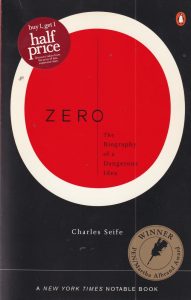 Zero: The Biography of a Dangerous Idea by Charles Seife. 248 pgs, 2000, Penguin Books.
Zero: The Biography of a Dangerous Idea by Charles Seife. 248 pgs, 2000, Penguin Books.
Seife writes about the history of the number zero, which you might think sounds boring but is quite fascinating, as not every culture back in the day had a zero, and he gets into why that was. I thought that this book would be fine for me for a while, until he started getting into higher level math, and I was right – when he’s dealing with everything prior to stupid Isaac Newton and stupid Gottfried Leibniz and their stupid invention of stupid calculus,* I was right there with Seife. Then, in the second half of the book, the math becomes more and more esoteric, and while Seife does a nice job explaining it, it’s just hard to wrap my head around it. Infinity and zero are so linked that we get into weird and wild stuff that makes no sense to me. I mean, I can even deal with imaginary numbers, but after that, I start to lose the plot. Oh well.
Still, early on in the book, the history of zero is quite fascinating. The ancient Egyptians and ancient Greeks had no use for zero, so they never discovered it, as they used geometry primarily to deal with area, and when you’re trying to figure out how big your farm is, zero is meaningless. They also had no use for infinity, which led to Aristotle “proving” the existence of God by claiming that outside of the “spheres” in which the planets moved, their was not infinite space but a Prime Mover. Early Christians dug this “proof,” so they ignored the Bible, which has no problem with infinity, and claimed the Aristotelian universe was where it’s at (imagine that – Christians ignoring something in the Bible that they, personally, didn’t like!). Zero became a hugely problematic idea for Christians (hence the subtitle of this book) until the Reformation and Enlightenment weakened the Church enough that it could no longer be ignored. The Indians came up with zero, because they had no problem with infinity, zero’s evil twin, and Jews and Muslims chose not to ignore the Bible (well, the Old Testament, at least, for the Jews) and fit zero right into their cosmology. Seife does a nice job with the Enlightenment era, as mathematicians and philosophers debated zero and where it fit in, and then he dives into calculus and all the other annoying math that only a tiny fraction of us can understand. Still, the way he highlights all the interesting ways zero is used in the world is pretty well done.
Overall, this is a nice, quick read that, I know, barely scratches the surface of what zero is all about. If you like this sort of thing, it’s a neat book that might tax your brain a bit (differential equations, yay!) but will also show you a side of history that doesn’t get discussed, because who cares when a society adopts a number? Seife points out that it might be more important than you thought it was!
* Honestly, I loved calculus. But that was back when I was young and spry. Now, it makes my brain hurt.
Rating: ★ ★ ★ ★ ★ ★ ★ ½ ☆ ☆
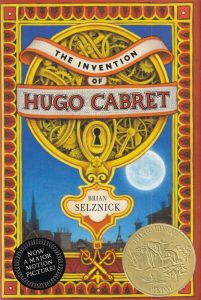 The Invention of Hugo Cabret by Brian Selznick. 533 pgs, 2007, Scholastic Press.
The Invention of Hugo Cabret by Brian Selznick. 533 pgs, 2007, Scholastic Press.
This book is over 500 pages long, and I read it in two days. I AM THE READING KING!!!!
Well, not really. As you might know, this is a YA book, and a lot of the pages have very little text on them, and the font is fairly large, and interspersed throughout the book are many illustrations that take up many full pages, so it’s a very quick read. The book takes place in 1931, and Hugo lives alone in a Paris train station (technically, the Gare Montparnasse, but it’s never named in the book), making sure the clocks run on time. It’s not his job, but his uncle had the job and disappeared, and Hugo – who’s an orphan – wants very much to avoid living in an orphanage, so he keeps doing the job and hopes nobody will discover what he’s doing. Meanwhile, he steals small things from a toy booth owned by an old man, who catches him one day. The old man discovers that Hugo has a notebook, inside of which are drawings of an automaton … which freaks the old man out and he takes the notebook away. Hugo is very upset by this, as it turns out he has the automaton in his room and he’s trying to figure out how to make it work. It’s part of a link to his dead father, but it also means something to the old man. What could it be?!?!?!?
I don’t want to give too much away if you’ve never read this or seen the movie, but it’s a charming story. Hugo is an interesting character, and he becomes friends with Isabelle, the old man’s goddaughter (another orphan!), who wants to help him and find out more about her godfather, who’s a bit mysterious and grumpy. Selznick commits a sin I don’t really love in writing – he makes the three main characters fairly unpleasant to each other simply because they want to keep secrets for no good reason – but it does keep the book from resolving too early, I suppose, so fine. (I don’t mind when characters keep secrets, but the characters seem to keep these simply because the author wants them to, and not because any in-story reason demands it.) It’s a charming book, with some real-world echoes, and I can see why Scorsese wanted to make a movie out of it. Selznick avoids moralizing, which is nice (too much YA fiction seems to do that), and he just tells a story that’s heart-warming and magical without being supernatural. It’s not hard to see why so many people dig it!
Rating: ★ ★ ★ ★ ★ ★ ★ ☆ ☆ ☆
TELEVISION
Mary & George (Starz). On the one hand, Julianne Moore plays Mary Villiers in this mini-series, and Moore is amazing, so it’s definitely worth seeing her do her thing. Her son, played with somewhat less excellence by Nicholas Galitzine (he’s not terrible, but he can’t compete with Moore), is George, the first Duke of Buckingham, who became James I’s lover in 1614 and remained in favor with the monarch even into Charles’s reign until his assassination in 1628 (yes, I know he’s technically “James VI and I,” but that’s obnoxious). This series is about how Mary connived to get George close to James and what happened afterward. James was with the Earl of Somerset at the beginning of the show, but Mary and George plot to get him removed, and George moves into his vacated spot. He is spectacularly ill-suited for the business of politics, but of course, he involves himself, and things get worse and worse for him and Mary. The big problem with the show is that everyone is pretty hateful. Mary is simply a plotter, and while her love affair with a hooker she meets early in the show is nicely done (and the hooker, played by Niamh Alger, is probably the most interesting and sympathetic character in this show, although she’s certainly not above scheming herself), generally she acts evilly throughout. George is a babe in the woods, and he never learns to control himself, which probably was a big reason why he was assassinated (an army officer killed him because George, apparently, did not worry too much about sacrificing his men in battle while, you know, he himself stayed safe). James, played by Tony Curran, isn’t completely evil (the show ignores a lot of his less redeeming qualities), but he’s led about by his lovers and has little interest in actually governing the country. Francis Bacon is another plotter who despises Mary, mainly because she’s a woman but also because she’s a social climber. Everyone is really, really horrible in this show, and it makes it difficult to fully engage with it. You kind of just want everyone to get killed (I guess Charles is ok, but that’s because he’s not king yet). The acting is good, the sets are really nice, and we get a good idea of what it was like to like in the early 1600s, as everyone kind of seems filthy, even as they dress up and get all fancy. I’m just a bit lukewarm about it, because I wanted someone to travel back in time with a machine gun and just start mowing everyone down. Such is life!
DI Ray season 2 (PBS). The second season of this show is pretty good, as our hero Parminder Nagra continues to fight against racism in her Birmingham constabulary. Last season, she was promoted and assigned a case specifically because it had an “Indian” connection (even though her character was born in England and doesn’t really think of herself as Indian), and this season, she’s dealing with some disciplinary stuff from last season but also getting involved in another case that doesn’t seem to have a racial aspect at first but soon does. A man shows up at a hospital, bleeding from a gunshot wound, but as a nurse tries to help him inside, a car pulls up and someone finishes the job, killing the nurse in the process. The man is a long-time gangster, and suspicion falls on an Indian family who appears to be trying to move in on his territory. Of course, because the nurse was white, this brings out the racists when the suspect’s identity gets out. DI Ray is technically in charge, but there’s a push from higher up to wrap the case up, as if an Indian cop arrests an Indian suspect, there can be no charge of racism, and also, it’s made clear that if she screws up somehow (despite not being allowed to pursue all the avenues in the case), she’ll take the fall. So, there’s a lot going on, and there are a lot of facets to the case that, while illegal, may or may not have anything to do with the murder. Nagra is good as usual, remaining stoic when she has to but making sure she has insurance in case things go sideways while also bringing a lot of repressed anger to Rachita Ray, as she is banging up against a system completely rigged against her. Gemma Whalen, as her immediate superior, also does a good job trying to play the middle, which she can only do for so long. I like these shows in which the murder case lasts for several episodes (in this case, the entire season), because it shows the difficulty in bringing pieces together, the time it takes, and the many things that could derail it … but I don’t love them because, unfortunately, too often the murderer is a bit more obvious than they make them out to be (in this case, the police have a very strong clue, they know about the very strong clue, but because the investigation leads into other illegal activities, they don’t pay enough attention to it until they circle back around much, much later). Still, it’s a solid cop show. Nothing wrong with those!
Professor T season 3 (PBS). After two seasons in which it felt that the characters’ personal lives moved like molasses, this season things zipped along, which is a bit odd. It began with last season’s finale, after which our title character, Jasper Tempest, finds himself in prison to begin this season. He discharged a firearm in a police station, but the charge is bumped up to attempted murder, so he has to go on trial for that. He’s protecting the head of the constabulary in Cambridge, with whom he used to be in love, but during the trial, she comes clean and he’s released … but she gets fired, oh dear. The team gets a new boss who has to be convinced to use Tempest’s services, and just when she does, the season ends … with a more horrific cliffhanger than in season 2! Oh dear. I always dislike killing off a character unless the actor specifically asks for it (some of them are twisted that way!), and it’s unclear if the character is dead (the season ends on a patented “fade out before we know the character’s fate!”), so we shall see what happens going into the next season. It’s especially annoying because the character is not stupid, but they act stupidly in their final (?) moments. Blech. Anyway, it’s fun to see our germaphobic professor in prison, although he does adjust a bit, and he’s still able to solve cases in prison because he’s just that damned smart. Frances de la Tour continues to be superb as Ben Miller’s truly awful mother (I mean, she’s not actively cruel or anything, she’s just a narcissist), and the cast is solid and the show looks wonderful (it’s filmed in Cambridge and Belgium). I’m curious what they’re going to do with the big cliffhanger ending!
**********
Here’s a look at the money I spent in July:
3 July: $34.25
10 July: $98.01
17 July: $74.53
24 July: $174.44 (Dang!)
31 July: $52.90
Money spent in July: $434.13
(Jul. ’23: $569.95)
(Jul. ’22: $740.07)
(Jul. ’21: $699.79)
YTD: $3616.09
2023: $3670.78
2022: $6258.80
2021: $4469.68
Here’s a breakdown of the publishers of books I bought in July:
Boom! Studios: 1 (1 single issue)
Cartoon Books: 1 (1 “classic” reprint)
Clarion Books: 1 (1 graphic novel)
Dark Horse: 3 (1 “classic” reprint, 2 single issues)
DC: 4 (2 single issues, 2 trade paperbacks)
Drawn & Quarterly: 1 (1 graphic novel)
Dstlry: 1 (1 trade paperback)
Fairsquare: 1 (1 graphic novel)
Fantagraphics: 1 (1 graphic novel)
Humanoids: 2 (2 graphic novels)
Image: 3 (1 graphic novel, 2 trade paperbacks)
Mad Cave: 1 (1 single issue)
Marvel: 3 (3 single issues)
Oni Press: 2 (1 single issue, 1 trade paperback)
SelfMadeHero: 1 (1 graphic novel)
2 “classic” reprints (27)
8 graphic novels (40)
0 manga volumes (5)
10 single issues (44)
6 trade paperbacks (69)
So far this year, that gives us this:
Ablaze: 0 + 1 + 0 + 0 + 0 + 2 + 0 (1 graphic novel, 1 manga volume, 1 trade paperback)
About Comics: 0 + 1 + 0 + 0 + 0 + 0 + 0 (1 “classic” reprint)
Abrams: 0 + 1 + 0 + 1 + 1 + 0 + 0 (3 graphic novels)
Ahoy: 0 + 1 + 0 + 0 + 0 + 0 + 0 (1 trade paperback)
Antarctic: 0 + 1 + 0 + 0 + 0 + 0 + 0 (1 trade paperback)
Avery Hill Publishing: 0 + 0 + 0 + 0 + 0 + 2 + 0 (2 graphic novels)
AWA: 0 + 1 + 1 + 1 + 0 + 1 + 0 (4 trade paperbacks)
Battle Quest Comics: 0 + 0 + 0 + 0 + 1 + 0 + 0 (1 trade paperback)
Boom! Studios: 1 + 1 + 0 + 2 + 0 + 0 + 1 (1 “classic” reprint, 1 single issue, 3 trade paperbacks)
Cartoon Books: 0 + 0 + 0 + 0 + 0 + 0 + 1 (1 “classic” reprint)
Clarion Books: 0 + 0 + 0 + 0 + 0 + 0 + 1 (1 graphic novel)
Clover Press: 0 + 1 + 0 + 0 + 0 + 2 + 0 (2 “classic” reprints, 1 graphic novel)
ComicMix: 0 + 0 + 0 + 0 + 1 + 0 + 0 (1 “classic” reprint)
Dark Horse: 3 + 3 + 1 + 3 + 1 + 2 + 3 (5 “classic” reprints, 8 single issues, 3 trade paperbacks)
DC: 1 + 3 + 4 + 5 + 2 + 3 + 4 (1 “classic” reprint, 11 single issues, 10 trade paperbacks)
Drawn & Quarterly: 0 + 0 + 0 + 0 + 0 + 0 + 1 (1 graphic novel)
Dstlry: 0 + 0 + 0 + 0 + 0 + 0 + 1 (1 trade paperback)
Dynamite: 0 + 0 + 0 + 0 + 1 + 1 + 0 (2 “classic” reprints)
Epicenter Comics: 0 + 0 + 0 + 0 + 1 + 0 + 0 (1 “classic” reprint)
Fairsquare Comics: 1 + 0 + 0 + 0 + 1 + 0 + 1 (2 graphic novels, 1 trade paperback)
Fantagraphics: 0 + 0 + 0 + 1 + 1 + 1 + 1 (2 “classic” reprints, 2 graphic novels)
First: 1 + 0 + 0 + 0 + 0 + 0 + 0 (1 graphic novel)
First Second Books: 1 + 0 + 0 + 0 + 0 + 0 + 0 (1 graphic novel)
Floating World Comics: 0 + 0 + 0 + 1 + 0 + 0 + 0 (1 graphic novel)
Humanoids: 0 + 0 + 0 + 0 + 1 + 0 + 2 (3 graphic novels)
IDW: 0 + 0 + 1 + 2 + 0 + 2 + 0 (5 trade paperbacks)
Image: 4 + 3 + 2 + 5 + 6 + 8 + 3 (2 “classic” reprints, 5 graphic novels, 5 single issues, 19 trade paperbacks)
Invader Comics: 0 + 1 + 0 + 0 + 1 + 0 + 0 (1 graphic novel, 1 single issue)
Mad Cave Studios: 2 + 1 + 0 + 1 + 3 + 1 + 1 (2 graphic novels, 3 single issues, 4 trade paperbacks)
Marvel: 3 + 3 + 2 + 4 + 1 + 3 + 3 (7 “classic” reprints, 7 single issues, 5 trade paperbacks)
MCD Books: 0 + 0 + 1 + 0 + 0 + 0 + 0 (1 graphic novel)
NBM: 0 + 0 + 0 + 1 + 0 + 1 + 0 (2 graphic novels)
Oni Press: 1 + 0 + 0 + 0 + 1 + 0 + 2 (1 single issue, 3 trade paperbacks)
Papercutz: 0 + 0 + 0 + 2 + 0 + 0 (2 “classic” reprints)
Penthouse: 0 + 1 + 0 + 1 + 0 + 1 (3 single issues)
Random House: 0 + 0 + 0 + 0 + 1 + 0 (1 graphic novel)
Scout: 1 + 0 + 0 + 0 + 0 + 0 (1 single issue)
SelfMadeHero Books: 0 + 0 + 0 + 0 + 0 + 0 + 1 (1 graphic novel)
Silver Sprocket: 0 + 0 + 0 + 0 + 0 + 1 + 0 (1 graphic novel)
SLG: 0 + 1 + 0 + 0 + 0 + 0 + 0 (1 graphic novel)
T Pub: 0 + 0 + 0 + 0 + 1 + 0 + 0 (1 graphic novel)
Ten Ton Press: 0 + 0 + 0 + 0 + 1 + 0 + 0 (1 graphic novel)
Titan Comics: 0 + 4 + 0 + 1 + 1 + 0 + 0 (1 graphic novel, 2 single issues, 3 trade paperbacks)
TKO Studios: 0 + 1 + 0 + 0 + 0 + 0 + 0 (1 trade paperback)
Top Shelf: 1 + 0 + 0 + 1 + 0 + 0 + 0 (2 graphic novels)
Valiant: 0 + 0 + 0 + 1 + 0 + 0 + 0 (1 single issue)
Vault: 1 + 0 + 0 + 0 + 1 + 1 + 0 (3 trade paperbacks)
Viz Media: 0 + 2 + 0 + 0 + 1 + 1 + 0 (4 manga volumes)
A Wave Blue World: 0 + 1 + 0 + 0 + 0 + 0 + 0 (1 graphic novel)
**********
Last weekend was the San Diego Comic Con, as you all should know, and I missed it again (it’s been … sheesh, a decade since I went?). Nothing much happened of any import in the realm of Marvel movies, of course, but the Eisner winners were announced, and you can see them here, among many other places (this just happened to be the site on which I first saw them). Anyway … they’re fine. Roaming cleaned up, which isn’t surprising (I liked it, but not as much as, I guess, a lot of other people), but I do like how Jillian Tamaki got an Eisner for artist for that book, because clearly there was far better art in many comics last year (and again, the art is perfectly fine, but, I mean, Juan Ferreyra shows more inventiveness and technique in single panels than Tamaki did in that entire book). I know the Eisners tend to be a tiny bit biased against superhero comics, but superhero art, at least, should be considered more often. I haven’t read Johnson’s Transformers, but sure, why not, and I am absolutely chuffed that Kelly won an Eisner, even though she’s done so much work that is so good and she wins for what is kind of a minor project. Still, good job, Kelly! Danger and Other Unknown Risks won for Best Teen Book, which makes me glad, as I couldn’t believe it didn’t make the CBR “Best of” list and I thought I might be taking crazy pills, so it’s cool to see other people actually read it and loved it. And then there’s Best New Series, which went to … Somna. SOMNA?!?!?! Yes, the softcore porn book that I reviewed in this very post (it’s true!)!!!! I mean, sure, party on, Eisner voters, but Somna is, as I noted above, notable solely because it’s softcore porn. It’s certainly not good enough to win an Eisner, but, hey, if voters were a bit titillated by it and wanted to reward that, more power to them. They all probably used to read Playboy for the articles, too.
Anyway, moving on, a few weeks back, over at The Ringer, they were celebrating horror movies, so they had a bunch of articles about them. I thought a few were pretty keen: the best kills, and horror movie superlatives. I’m not the biggest fan of horror movies, but I do like reading about them!
On a more serious note, a few things have dominated the news in this country, at least, in recent weeks. Firstly, of course, is the news of Joe Biden not running for president, which I thought was a good move. I kind of wish he had run and won, and then on the day after his inauguration, resigned and turned things over to Harris, because that would have made Republicans lose their actual shit, but they’re losing it right now, so it’s all good. I wish Biden had done this a bit earlier, because he was never a great candidate or president, just someone who wasn’t motherfucking Donald Trump, and he’s actually done better as president than most people want to give him credit for. Now, he can do president things (like call for Supreme Court reform, which, honestly, he should have done first in his term, but better late than never) and Harris can campaign and hammer Trump, as she’s been doing. Biden seemed, even in 2020, to want to run a traditional campaign, and it worked for him, but he’s gotten older and Trump, almost impossibly, has gotten weirder, so it’s nice to see Harris calling him out on his (and JD Vance’s) weirdness. Trump is so weird that it seems like the media lets him get away with horrible shit, like telling Christians recently that if he wins, they won’t ever have to worry about voting again, which his campaign tried to pass off as a joke but which seems perfectly in line with so many of his other “jokes” about being a dictator, plus the very non-joke decision by the Supreme Court that Trump can do whatever he wants and never be prosecuted. Harris isn’t letting him off the hook, which is nice to see. Trump is running scared a bit, and he certainly doesn’t want to go face-to-face with her. When Clinton ran in 2016, I think everyone was a bit blindsided by Trump’s bullying tactics, because they weren’t normal. Clinton lost because she ran a bad campaign, at least partly because she didn’t take Trump seriously. I think Harris has learned from that and takes Trump very seriously, even though he’s a joke of human being. Even a joke of a human being can still do a lot of damage, as we’ve seen far too often in history. I do hope this energizes everyone to deal the Trump Republican Party a death blow, because, as I’ve said before, they need to have a reckoning, and losing elections only by a little bit won’t do it. They need to be ground into sand before they can understand that they need to purge the party of the loons who surround Trump. If they win (Jeebus, God forbid) or only lose by a little, we’ll have to endure at least one more election cycle with these crazy people, and that’s just not good. Crazy groups who don’t know anything about governance need to be destroyed in polls so their supporters will realize the folly of supporting them. I do hope it happens this year, because it’s just exhausting listening to them talk about Hannibal Lector and what a great dude he was or how crazy cat ladies are ruining the country or any of the other bonkers stuff they ramble about. I’m sick of it.
And then, of course, the Olympics opened and conservatives lost their shit again. I mean, come on. So, I haven’t watched the Olympics in any meaningful way (beyond a few minutes here and there, in other words) in 40 years, so I ignored the opening ceremonies. On Saturday morning I went to play tennis, as I do, and one of the dudes told me he was very offended by it, because they did a parody of the Last Supper with drag queens. He’s a “Jack Mormon” to a degree – he’s Mormon but not overly observant – but he didn’t like that. To his credit, he didn’t really care that they were drag queens, more that they were mocking the Last Supper. I had, remember, not seen the show, so all I said was that it seemed very weird to do something like at the opening ceremonies of the Olympics. Whether you approve or disapprove, whether you’re offended or not, it’s just weird. Of course, it was not the Last Supper, and a bunch of conservative Christians have come off looking like the buffoons they often are, so it makes more sense now. Unfortunately, my tennis-playing acquaintance often travels for work, and I didn’t see him this week, but maybe I’ll ask him on Saturday (if he’s there) if he’s changed his mind. I did enjoy the kerfuffle, because these people are just so quick to mock others for being offended, but they literally get offended at everything. Even if it had been the Last Supper, so what? Is your faith so tenuous that someone mocking it means it’s invalid? I never understand this – if you’re a Christian, you believe in a very specific thing, and more importantly, you believe this grace offered to you by Jesus gets you into Heaven, which is where we all want to end up anyway. How does mocking your faith change that in any way? You’re focused on the next life, so what does it matter if a bunch of drag queens make fun of you? (Which, again, they didn’t.) I get that no one likes to be mocked, but for a lot of Christians (and, to be fair, any other group that believes they’ve been selected by God for special favors), there’s a vague air of superiority about their beliefs, so wouldn’t you just pooh-pooh the mockers and say something like, “You’re just jealous”? I mean, those drag queens will be down in Hell while you’re up in Heaven, and you can give ’em the old Rorschach:
Isn’t that what they all want anyway? So what do they care?
Speaking of weirdos, here’s a bizarre sexist rant by some Daily Wire dude. See? Bonkers. I blame the internet – everyone has a forum these days, so they can just rant about anything and someone, somewhere will see it and propagate it. These people used to live in one-bedroom apartments and eat pork rinds all day, now they’re minor celebrities! (N.B. Of course, the noble art of comics blogging is totally excluded from this blanket condemnation!!!!)
**********
The big news in my life is that the 30th of July was my 30th wedding anniversary. I’m sure you all had the under, so pay up! It’s been a very cool adventure, and I have no idea where it’s going, but I can’t think of a better person to spend it with than my lovely bride. I posted a bunch of photos on Facebook, trying to get a photo of us together in every year we’ve been together (didn’t quite make it, as in some years we just never got photos taken together!), so if you want to see a progression of me getting fatter and uglier, feel free to click the link below. Won’t that be fun!
I hope everyone is having a nice time – I’m sure Eric has gone to more concerts than we can ever imagine (sorry about the lack of music again, Eric – I promise I’m working on it!) and Fraser has bad opinions about comics, like usual (I kid, sir, I kid!!!!), and I hope everyone enjoyed reading this, if indeed you did. I know some people I know in real life read this occasionally, so hi, Tyson, the 49ers suck! Have a great day, everyone!





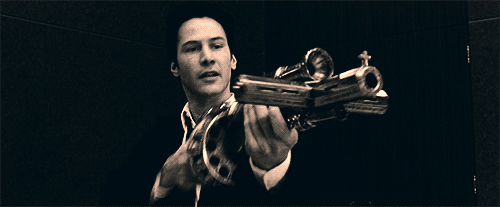









I posted a long-ass post about the republicans but the comment section ate it, darn it. Anyway, I hope they lose hard, but I don’t see them changing even if they lose every seat and the presidency.
Anyway, lovely photos man, 30 years sounds like a long time until you are married and see that the time sometimes flies
Dang, sorry about that! Sometimes the comments section just gets ornery, and I’m not sure why!
I don’t think one electoral disaster will change them, no. But they have to start losing badly, because if they keep winning a little and losing a little, they’ll never change. If they have many disasters in a row, they might change, and it might as well start this year! 🙂
Thanks for the nice words. We’ve had a great time, and you’re right – it seems like no time has passed!!
So, let’s talk about comics because this month I did get some comics, yay me
Actually I got two comics during prime day: The first 2 sets of something called “The Calvin & Hobbes portable compendium” I was thinking of getting the big Calvin & Hobbes volume, but my kid is reading more than ever and I decided that even if this is more expensive in the long run(I mean, they are going to do seven sets, cheaper individually but more expensive eventually) this would be a better experience for her, since the volumes are smaller and more, well, portable.
And my wife likes a newspaper strip called “Mafalda”. To be honest, Mafalda is pretty good, so I was ok getting a Mafalda Collection. But unlike the portable compendiums, the only complete collection we could find was a monster of a comic called “todo mafalda” that is pretty much the size of a DC absoulte edition. So yeah, so much for portability. Buy anyways, doesn’t matter because the kid loves both strips, so yay, more reading for all of us.
I wanted to comment something about the Eisners, but damn it I just don’t recognize any of those comics. I’m really behind in the comic world, so the most recent comic I have is from like 2014 or so.
You gotta start buying new comics again! 🙂
Re: “Trump is so weird that it seems like the media lets him get away with horrible shit…”
And this has been the problem since he entered electoral politics. Everyone in the media seems to let him get away with, and thus normalize, every idiotic, creepy and outrageous thing he says and does.
I remember back in 2017 (like around April), I was struck by a news piece about something Trump said at one of his rallies, and my first thought was: “The election is over! He’s president now! Why the f*** is he still holding rallies?! Why the f*** isn’t that the top story that everyone’s talking about?!” Instead, it just became accepted that Trump is going to keep on touring the country and holding rallies, like Mussolini or Ceausescu. And then he basically foments an insurrection, and instead of ending his political career (and really, ending with him in prison, which is where he should be for that, the treasonous f***), it’s just a little speed bump in his political fortunes.
Re: “I’m sick of it.”
Oh, god, I’m beyond sick of it…
I think of it as a branding thing. Trump’s brand is “he’s a psycho who says crazy shit” so now it’s taken as a given. As one journalist said recently, he performed horribly at the debate but for him it was “normal.”
For another example, it came out a few years ago that Jared Kushner recommended not doing much about covid in the belief it would hit blue states mostly. If someone in Biden’s administration had expressed a similar idea it would have dominated the news cycle for weeks. But the media have accepted the Republican Party do that shit so it’s no longer news.
“You’re focused on the next life, so what does it matter if a bunch of drag queens make fun of you?” Because when Jesus says “what profit you to gain the world if you lose your soul” they think that sounds like a sweet deal (as liberal evangelical Fred Clark puts it).
He’s done so many things where I thought that same thing, and it didn’t, so you’re right. I mean, he mocked a disabled person live on camera, which I thought would wreck him, but it barely registered. Sheesh.
Yeah, the branding thing annoys me so much. “Oh, it’s just what he does” is something you say about your crazy uncle who shows up at Thanksgiving spouting racist things – he’s 80 years old and he’s never going to change! Trump is that crazy uncle, except people are out there voting for him, but the media still treats him as the harmless crazy uncle!
I appreciate that you buy so many things on my “maybe” list that I may have passed on. I thought about Census– I did some census taking back in 2010– and Faceless and the Family but passed mainly on price/budget reasons.
I have the original Rock Candy Mountain trades but still haven’t read them. Did you pick up Starks’ Karate Prom? It’s a little too YA for me, but gets better as it goes.
Due to DC’s bizarre publication schedule, I’ve already pre-ordered World’s Finest through volume 4! I thought the first volume was fine, but hopefully it improves a little. Haven’t received v2 yet.
I suffered through AP Calculus in high school and barely escaped with my life.
Other items from my latest box o’ comics I have read:
– Barda by Ngozi Ukazu: One of my favorite reads of the year. Ukazu really nails the balance between the YA and Kirby tones, and has a good handle on the characters. Really enjoyable.
– Cyn (Humanoids) by Ibrahim Moustafa et al, which is a spinoff of Count. It’s just a well-done sci-fi western action book. Probably nothing you haven’t seen before, but well-executed, at a brisk pace.
– Flash v1 by Si Spurrier and Mike Deodato Jr. The art here is fascinating. Deodato is still using celeb faces, but his gridwork is crazy, and it actually ties into Spurrier’s plot about different planes of existence. Letting by Hassan Otsmane-Elhaou is excellent, using Silver Age balloon shapes. The story is a lot to wrap my head around, but it’s like a Silver Age plot updated for quantum physics and weird fiction.
– Hulk: Blood Hunt by Phillip Kennedy Johnson and Danny Earls– it turns out this will be in the next trade, but I didn’t know that. Great one-off that barely connects to the crossover, about a fake Western town built for movies and immigrants crossing the border being killed by vampires. The false facade of the American dream and the bodies it buries. Good stuff.
– Junior Baker the Righetous Faker by Joe Casey and Ryan Quackenbush: Weird book! I liked the beginning more than the ending.
– Penguin v1 by Tom King, Rafael De Latorre, and Marcelo Maiolo: So this is kind of a retread of the Penguin One Bad Day one-shot from not that long ago, plus King does his thing where he recontextualizes the character into something that doesn’t quite work for me. But he also revamps one of the most obscure DC characters ever.
That Flash sounds interesting. I might have to track it down.
I skipped Moustafa’s thing, because it just sounded too generic for me. I do like the work he’s been doing the past few years, so I hope he keeps it up!
Which obscure character, sir? WHICH ONE?!?!?!?
I never heard of her before Googling it, but he brought back Lisa St. Claire, a recurring character from Young Love in the late ’60s, only now she’s sort of Penguin’s evil ex-wife. I assume he discovered this character whilst researching Love Everlasting.
What’s wrong with Playboy? I only buy it for the articles. The one about the theory of relativity was very interesting. 😉
Just 1 concert last month Greg!
4/7 Anneke van Giersbergen and Floor Jansen
The concert would have taken place last year but due to the pregnancy of Floor it was postponed. They had a wonderful location for the concert, namely the garden of Palace Soestdijk. It was the residency of late queen Juliana. Since 2017 they organize concerts over there.
Anneke with just a guitar was amazing and the main reason for going there. Floor Jansen was ok. Too bad she played mostly covers.
Shirt : YES. Normally Anneke doesn’t have them at shows but luckely we both got a nice one.
Congratulations with your wedding anniversary. We have 27 years to go to get to that anniversary. 🙂
The best thing about the opening ceremony was the performance of 1 of mine favorite bands : Gojira. https://www.youtube.com/watch?v=miMI6pHAqY0
The last supper thing? It bit too woke for me, but I know that a lot of people liked it.
Let’s see if the people with more than 1 brain cell make the right decision in november while voting.
Playboy did have very good articles, I admit. But come on – that’s not why you buy it!!!! 🙂
I saw that Gojira performance. Kind of impressive.
But it wasn’t the Last Supper, that’s the point!!!! People just thought it was because they have no artistic culture, so they see a table which a bunch of people sitting around it Renaissance clothing and they think “It’s the Last Supper.” It wasn’t!
I will say that I think you’re underrating Biden’s performance as president – he’s very, very good at the actual work of being PotUS…he’s just never been able to communicate it, because he’s way too goddamn old to be president.
Love the Tim Walz pick for Harris, too – brings a very similar energy to the young Biden who was a capable communicator…which really shows with stuff like the “Creepy and Weird” line he originated.
But yeah, wanted to love World’s Finest…and it’s just a good, B+ cape book. Excited to see Waid/Mora on Justice League Unlimited, though!
My favorite ongoing in July has to be Get Fury, though – Ennis+MAX=Win…which is why you should skip the Marvel Knights stuff, pick up “Born” and go straight into PunisherMAX #1, haha!
I think he’s been good, but I also think he’s dropped the ball on some things that seem obvious in terms of shoring things up after Trump – the court reform, in other words. I think after the 2020 election, he really had a chance to change important things, and he just moved slowly on it. Not too big a deal, because you’re right – the things he’s actually worked on, he’s done well on – but I hope, if Harris wins, she doesn’t miss the opportunity.
I tried Punisher MAX, I swear! It just didn’t do it for me!